Discover a serene fishing community with rich marine biodiversity and authentic Maldivian culture in Baa Atoll's UNESCO Biosphere Reserve
Located in the Baa Atoll UNESCO Biosphere Reserve, Kihaadhoo Island offers visitors an authentic glimpse into traditional Maldivian island life. This peaceful island maintains its natural beauty and cultural heritage while providing access to some of the Maldives' most spectacular marine environments.
What makes Kihaadhoo special is its strategic location within the Biosphere Reserve and strong community bonds. The island's traditional way of life centers around fishing, with generations of skilled fishermen using sustainable methods passed down through centuries. With a modest population, visitors experience an intimate atmosphere where they're welcomed as guests rather than treated as tourists.
Visitors to Kihaadhoo are drawn by its excellent access to marine hotspots, including the world-famous Hanifaru Bay, opportunities for authentic cultural immersion, and the chance to experience a genuine Maldivian community. The island's slower pace of life, stunning marine environment, and genuine cultural experiences make it an ideal destination for travelers seeking to discover the authentic heart of the Maldives beyond the luxury resorts.
Kihaadhoo Island is situated in the eastern part of Baa Atoll, approximately 120 kilometers northwest of Male. The island enjoys a strategic position within the atoll, surrounded by crystal-clear waters and vibrant coral reefs that are part of the UNESCO Biosphere Reserve.
Its location provides excellent access to the region's most celebrated marine environments, including the world-famous Hanifaru Bay, known for its seasonal aggregations of manta rays and whale sharks. Kihaadhoo's position makes it an ideal base for exploring the natural wonders of Baa Atoll while experiencing authentic island life.
Kihaadhoo Island is renowned for its strong fishing traditions that have sustained the community for generations. Fishing remains not just an economic activity but a cultural cornerstone that shapes daily life, community relationships, and local identity.

Kihaadhoo fishermen continue to practice traditional pole-and-line fishing, a sustainable method that has been used for centuries in the Maldives. This technique prevents overfishing and bycatch while preserving marine ecosystems.
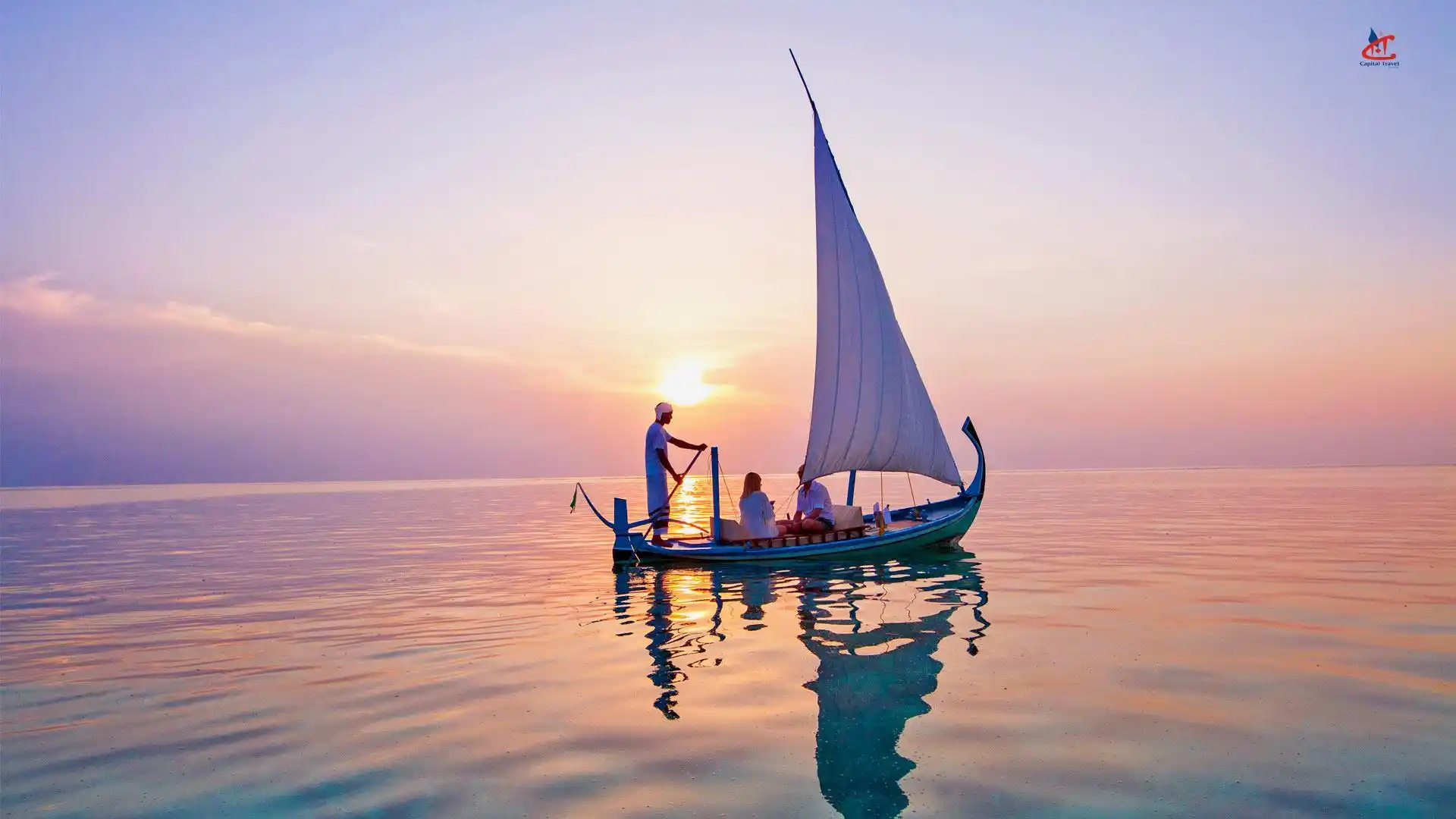
The island's harbor is home to traditional fishing dhonis (wooden boats) alongside more modern vessels. These boats, often hand-crafted using techniques passed down through generations, remain central to the island's fishing fleet.
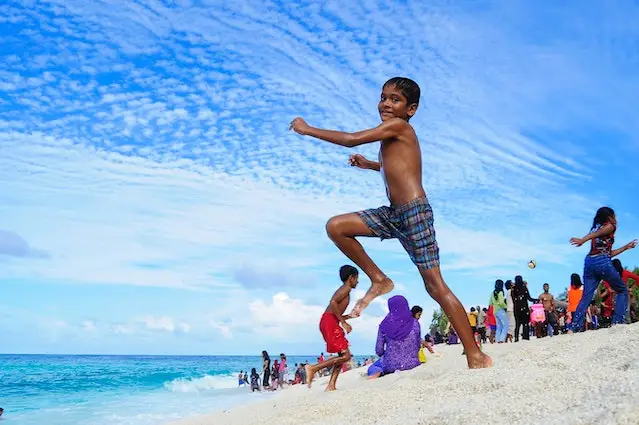
Fish processing remains a community activity, with families working together to clean, fillet, smoke, and dry the daily catch. These traditional preservation methods create specialty products like the famous Maldivian dried fish.

Travelers can participate in traditional fishing trips with local fishermen, learning sustainable techniques while experiencing an authentic aspect of Maldivian culture handed down through generations.
Fishing permeates every aspect of Kihaadhoo's culture:
This deep connection to the sea shapes not just livelihoods but the island's cultural identity and community bonds.
Kihaadhoo's fishing community demonstrates impressive sustainability:
These practices have helped maintain healthy marine ecosystems around Kihaadhoo for generations.
Kihaadhoo Island is known for its preservation of traditional Maldivian customs and cultural practices. The island community maintains many time-honored traditions that offer visitors authentic insights into Maldivian culture.

Kihaadhoo is known for its skilled artisans who continue to practice traditional crafts. The island has a reputation for fine coir rope making, with coconut husks processed and twisted into strong, durable rope used for boat building and various household purposes. Some families specialize in traditional mat weaving (thundu kunaa), creating intricate patterns from dried reeds. These colorful mats are used in homes and also sold as souvenirs.
Visitors can observe these crafts being made and sometimes participate in demonstrations arranged through guesthouses. Many artisans sell their creations directly to visitors, providing authentic souvenirs while supporting local traditions.

Traditional music and dance remain important cultural expressions on Kihaadhoo. Boduberu, the most popular form of traditional Maldivian music, features rhythmic drumming accompanied by dancing that gradually increases in tempo and intensity. These performances often take place during community celebrations and special occasions. The island observes traditional festivals throughout the year, including Islamic holidays like Eid, which are celebrated with special meals, community gatherings, and cultural performances.
Visitors may have the opportunity to witness or even participate in Boduberu performances, especially if their stay coincides with local celebrations. Some guesthouses arrange cultural evenings where guests can experience these traditional art forms.
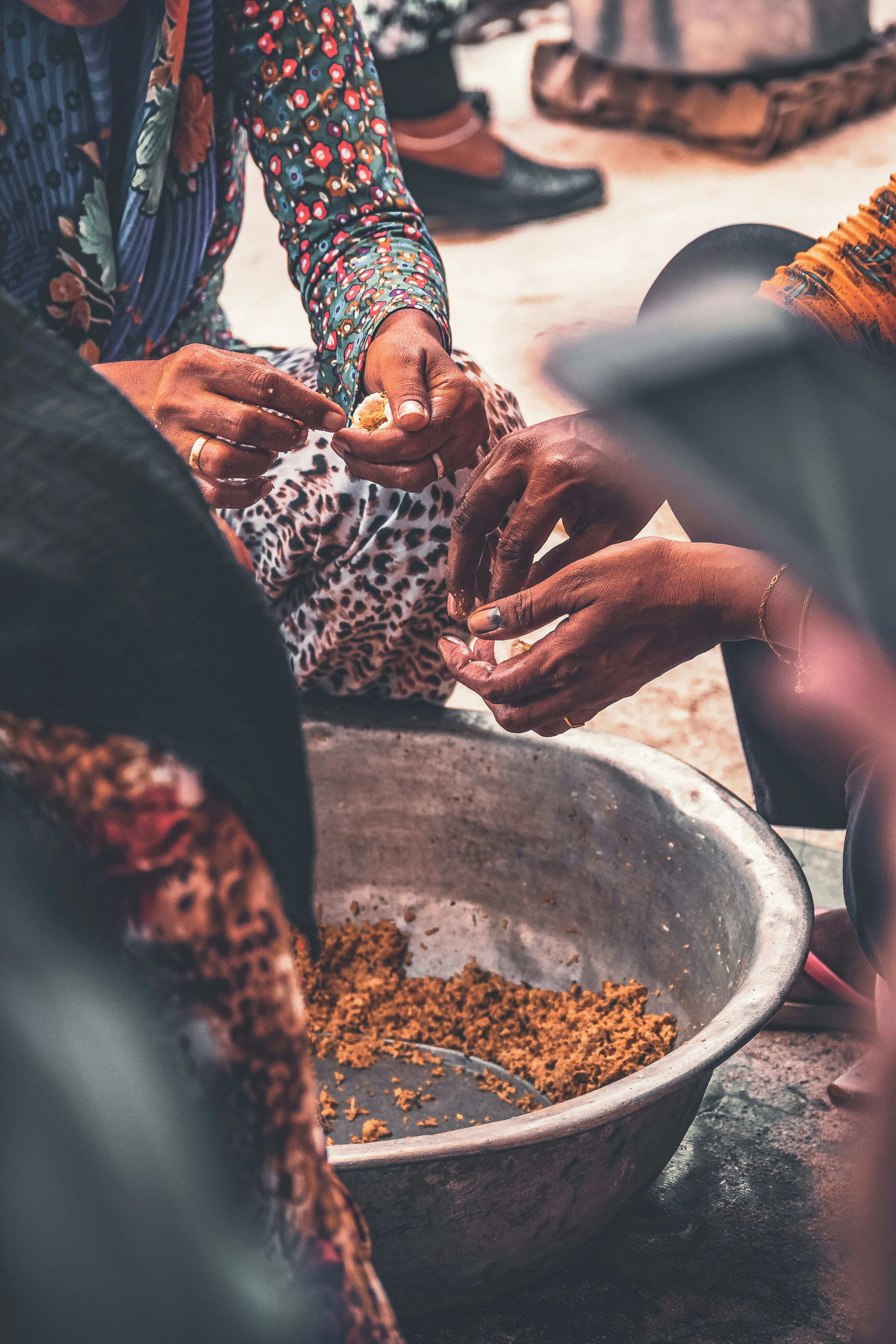
Kihaadhoo's cuisine reflects traditional Maldivian flavors with an emphasis on seafood, coconut, and spices. Fish is the staple protein, prepared in various ways including grilled, curried, or dried and smoked. Mas huni (a breakfast dish of shredded smoked tuna mixed with grated coconut, onion, and chili) is a daily staple. Garudhiya (clear fish broth) served with rice, lime, chili, and onions is another common dish. Coconut features prominently in many preparations, from fresh coconut milk in curries to grated coconut in desserts and snacks.
Visitors staying in guesthouses typically enjoy home-cooked Maldivian meals, offering an authentic taste of local cuisine. Some hosts offer cooking demonstrations where guests can learn to prepare traditional dishes.
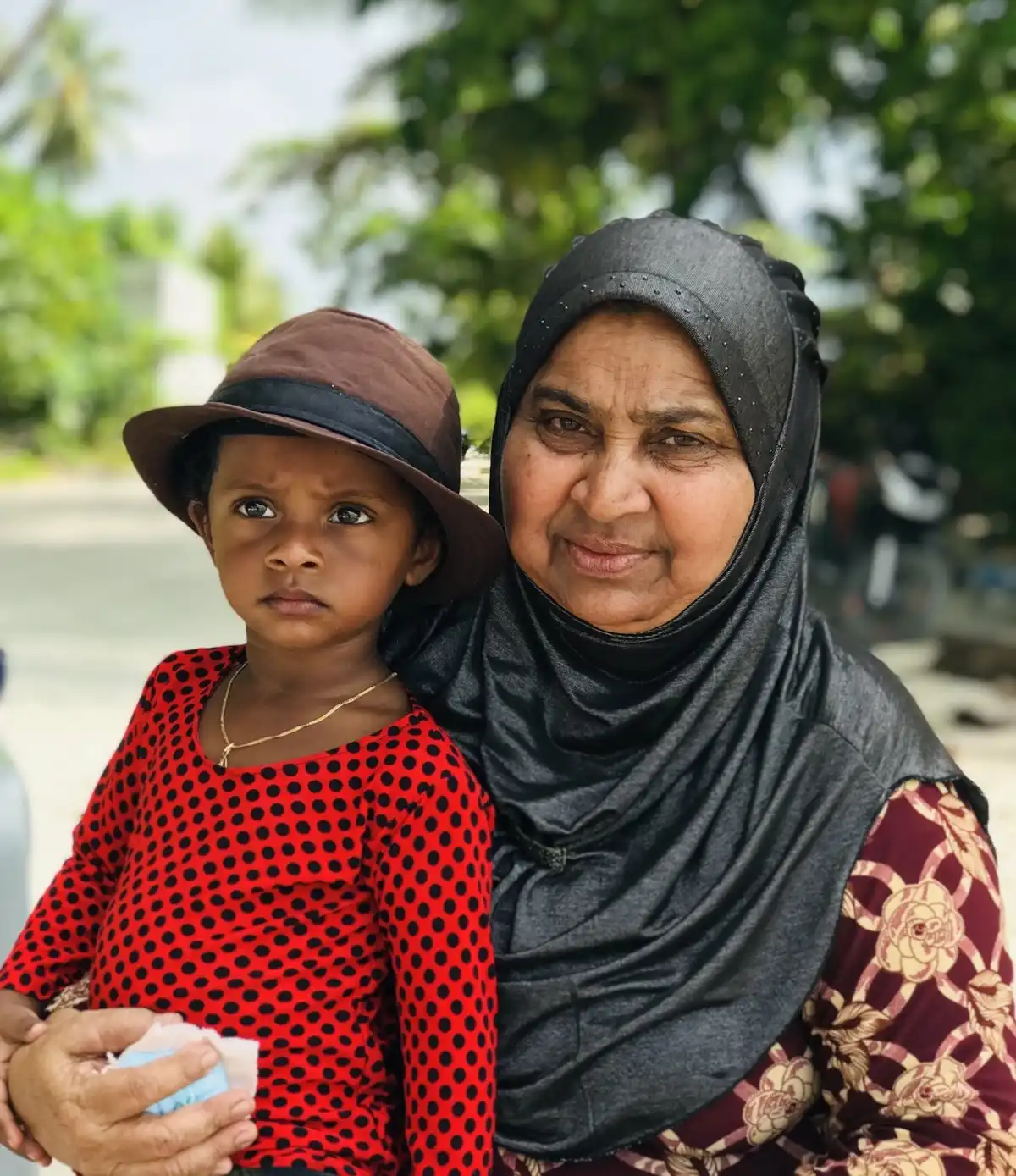
Kihaadhoo maintains strong community bonds through collective activities and shared responsibilities. Community work projects (known as fenaka jehun) bring residents together to maintain public spaces, clean beaches, or assist with construction projects. Islamic traditions shape daily life, with prayer times marking the rhythm of the day and the mosque serving as a community focal point. Family structures remain strong, with extended families often living close together and sharing responsibilities for childcare, cooking, and household management.
Visitors can observe these community dynamics during their stay, gaining insights into the cooperative social structure that has sustained island life for generations. The genuine hospitality extended to guests is itself a reflection of traditional Maldivian values.
Kihaadhoo offers a select range of accommodation options that focus on authentic experiences and local hospitality. While more limited than some of the larger islands, the accommodations here provide genuine warmth and a true connection to island life.

Several family-operated guesthouses offer clean, comfortable accommodations with a personal touch. These properties typically feature air-conditioned rooms with private bathrooms, home-cooked Maldivian meals, and direct access to local knowledge through the host families.
Price Range: $45-70 per night
Features: Authentic hospitality, home-cooked meals, cultural insights, local excursion arrangements

For travelers seeking deep cultural immersion, homestay experiences are available with local families. These provide the most authentic glimpse into island life, with guests sharing meals and daily activities with their host family while enjoying basic but comfortable accommodation.
Price Range: $35-55 per night, including meals
Features: Cultural immersion, family interaction, traditional meals, daily island activities

A small number of simple beachfront cottages offer a more private experience while maintaining a connection to local culture. These modest accommodations provide direct beach access and a peaceful environment for those seeking a balance of comfort and authenticity.
Price Range: $60-90 per night
Features: Beach access, privacy, basic amenities, natural surroundings
Kihaadhoo offers basic facilities that meet visitor needs while maintaining its authentic island character. The infrastructure supports daily life for locals and provides essential services for travelers without compromising the island's traditional atmosphere.
The island has several small local shops providing basic necessities, snacks, beverages, and toiletries. These family-run convenience stores stock essentials for both locals and visitors.
Most meals are provided by guesthouses featuring fresh seafood and traditional Maldivian cuisine. The island also has a couple of small local cafés serving snacks, tea, and coffee in a casual setting.
Kihaadhoo has a small health center with basic medical services. For serious conditions, patients are transferred to Eydhafushi (atoll capital) or Male for treatment.
Mobile coverage is available from both Dhiraagu and Ooredoo networks. Most guesthouses offer Wi-Fi, though connectivity may be slower than in more developed areas.
The island relies on a combination of rainwater collection systems and groundwater. Most guesthouses provide filtered drinking water for guests, and bottled water is available in local shops.
Kihaadhoo has a central power plant providing electricity throughout the island. Power is generally reliable, though occasional brief outages may occur. Some accommodations have backup generators.
The island has a central mosque serving the local population. Visitors are welcome to view the exterior but should dress modestly and respect prayer times.
Kihaadhoo has a small harbor that serves fishing boats and visitor transfers. The harbor area is a hub of activity, especially when fishing boats return with their daily catch.
Kihaadhoo is blessed with pleasant beaches and a spectacular marine environment. The island's location within the UNESCO Biosphere Reserve has helped preserve the surrounding reefs in excellent condition, making it a paradise for snorkeling and marine enthusiasts.
Kihaadhoo features several beach areas around its perimeter. While not as extensive as some islands, these beaches offer pleasant areas for relaxation and swimming. The eastern beach is particularly nice, with white sand and clear waters. The northern beach area offers views toward nearby uninhabited islands and is popular for sunset watching.
The island has a designated "bikini beach" where tourists can wear Western-style swimwear. This beautiful stretch of sand provides a relaxing environment while respecting local cultural norms. The remaining beaches require modest dress as they are used by the local community.
One of Kihaadhoo's greatest natural assets is its vibrant house reef, accessible directly from several points around the island. The reef features healthy coral formations and abundant marine life, offering excellent snorkeling opportunities just steps from the shore. The house reef's accessibility makes it possible to enjoy multiple snorkeling sessions throughout the day without needing boat transportation.


The waters around Kihaadhoo Island offer exceptional marine biodiversity, making it a paradise for underwater enthusiasts:
The island's location within the UNESCO Biosphere Reserve has helped preserve Kihaadhoo's marine environment in exceptional condition.
Kihaadhoo offers a range of activities that blend natural experiences with cultural immersion. The island's authentic character provides visitors with opportunities to connect with both nature and traditional Maldivian lifestyle.





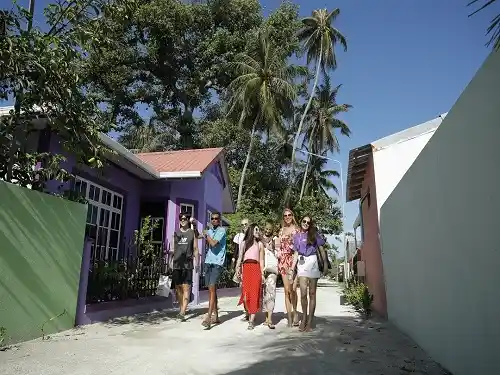


Kihaadhoo is home to a close-knit community of approximately 700 residents who maintain strong traditional values while adapting to modern influences. The island's population is known for its warm hospitality, fishing expertise, and preservation of authentic Maldivian culture.
Daily life on Kihaadhoo follows the rhythm of traditional island routines, centered around fishing, prayer times, and community gatherings. Mornings begin early as fishing boats depart before dawn, returning mid-morning with their catch. The island awakens with the call to prayer, followed by a day of work, family responsibilities, and community interactions. Evenings often find residents gathering in public spaces, sharing news, and socializing as the day cools.
Kihaadhoo preserves many traditional Maldivian customs and cultural practices. Religious observances play an important role in community life, with festivals like Eid celebrated enthusiastically. Cultural expressions such as Boduberu performances remain vibrant, while traditional crafts including coir rope making, mat weaving, and boat building are still practiced by skilled artisans.
What makes Kihaadhoo's community special is its strong sense of unity and mutual support. Island residents work cooperatively on community projects, share resources, and maintain close social bonds. This communal approach to life creates a warm atmosphere where visitors are genuinely welcomed and quickly made to feel part of the island's extended family rather than just tourists passing through.


Discover the genuine warmth, traditional culture, and natural beauty of Kihaadhoo Island. Book your stay today for an unforgettable and authentic Maldivian experience in Baa Atoll's UNESCO Biosphere Reserve.
Plan Your TripKihaadhoo Island is accessible via several transportation options. The most convenient route is by domestic flight from Velana International Airport to Dharavandhoo Airport (approximately 30 minutes), followed by a 20-minute speedboat transfer to Kihaadhoo. This combined journey costs around $120-140. A more economical option is the public ferry from Male, which operates weekly and takes approximately 8-9 hours, costing about $4-6 per person. Private speedboat transfers can also be arranged through guesthouses (approximately 3-4 hours from Male, costing around $70-90 per person). Island hopping is another option, with connections available from Eydhafushi (the atoll capital) via local boats. Most guesthouses on Kihaadhoo can arrange transfers and will provide detailed information about the best options based on your arrival date and preferences. It's advisable to plan your transportation well in advance, especially during high season (November to April).
The best time to visit Kihaadhoo Island depends on your interests. For general beach and snorkeling activities, the northeast monsoon season (November to April) brings dry, sunny weather with lower humidity and calmer seas. This period is ideal for water activities, with water visibility often exceeding 20-30 meters. January to March typically offers the most reliable weather conditions with minimal rainfall. If you're specifically interested in manta ray and whale shark encounters at nearby Hanifaru Bay, plan your visit between May and November, with peak season being June to October when plankton concentrations attract these magnificent creatures. The southwest monsoon season (May to October) brings occasional rain showers and slightly rougher seas, though there are still many sunny days. This period offers advantages including fewer tourists, lower prices, and the chance to witness the spectacular marine life aggregations in the UNESCO Biosphere Reserve. For cultural experiences, the island hosts various festivals throughout the year, with Islamic holidays like Eid being particularly festive times to visit. Water temperature remains warm (27-30°C/80-86°F) throughout the year, making Kihaadhoo a viable destination in any season depending on your preferences.
Kihaadhoo distinguishes itself from other local islands through several unique characteristics. First, its strategic location within the Baa Atoll UNESCO Biosphere Reserve provides excellent access to marine highlights like Hanifaru Bay while maintaining a more authentic atmosphere than some of the more tourism-focused islands. Second, the island has maintained a strong fishing tradition, with the community's economy and daily rhythms still centered around traditional fishing practices. The harbor comes alive when fishing boats return, providing visitors with insights into this important aspect of Maldivian heritage. Third, Kihaadhoo offers a genuine community experience, with visitors often invited to participate in local activities and celebrations, creating opportunities for meaningful cultural exchange. Fourth, the island has developed tourism thoughtfully, with a focus on sustainable practices that preserve both the natural environment and cultural heritage. Fifth, the island's relatively small size and modest visitor numbers ensure a more intimate experience where travelers can truly disconnect from the modern world and immerse themselves in island life. For travelers seeking to experience the authentic heart of the Maldives while still enjoying comfortable accommodations and access to natural wonders, Kihaadhoo offers an ideal balance.
The waters around Kihaadhoo offer exceptional marine biodiversity, making it a paradise for snorkelers. The island's house reef features healthy coral formations with both hard corals (brain coral, staghorn coral, table coral) and colorful soft corals creating a vibrant underwater landscape. Reef fish are abundant, including various species of butterflyfish, angelfish, parrotfish, surgeonfish, and triggerfish displaying spectacular colors. Blacktip and whitetip reef sharks are commonly spotted patrolling the reef edges, particularly in the morning and late afternoon. Green and hawksbill sea turtles can be observed feeding on seagrass beds or resting among coral formations. Various ray species inhabit the surrounding waters, including eagle rays and stingrays often seen gliding over sandy areas adjacent to the reef. Moray eels, octopus, and reef cuttlefish provide fascinating encounters for observant snorkelers exploring coral crevices. During certain seasons, schools of jackfish, tuna, and trevally create impressive underwater spectacles. The nearby Hanifaru Bay (accessible by boat excursion) offers the opportunity to witness manta ray and whale shark aggregations during the southwest monsoon season (May-November). With water visibility often exceeding 20-30 meters during optimal conditions, snorkelers can enjoy clear views of this underwater paradise. The island's location within the UNESCO Biosphere Reserve has helped maintain healthy marine ecosystems with minimal human impact, resulting in exceptional biodiversity compared to more developed areas.
Visiting Kihaadhoo requires some special considerations due to its remote location and limited infrastructure. First, plan your transportation carefully, as public ferries operate infrequently and private transfers should be arranged well in advance. Second, pack essentials as shopping options are extremely limited - bring any medications, specific toiletries, sunscreen, insect repellent, and other personal necessities you might need. Third, bring sufficient cash as there are no ATMs on the island, and credit cards are rarely accepted. Fourth, prepare for limited connectivity - while mobile signals are available, internet access may be slow and intermittent, making Kihaadhoo perfect for a digital detox. Fifth, adjust your expectations regarding amenities - accommodations are clean and comfortable but basic, with limited hot water and potential power fluctuations. Sixth, respect the conservative local culture by dressing modestly in public areas and observing local customs. Seventh, be self-sufficient in terms of entertainment - bring books, games, or other offline activities as there are no organized entertainment venues. Eighth, consider bringing small gifts for your host family or local children, such as school supplies or practical items. Ninth, pack a good first aid kit as medical facilities are basic. Finally, embrace flexibility and patience - island time moves at a different pace, and weather conditions can affect planned activities. With the right preparation and mindset, these considerations become part of the authentic experience that makes Kihaadhoo so special.